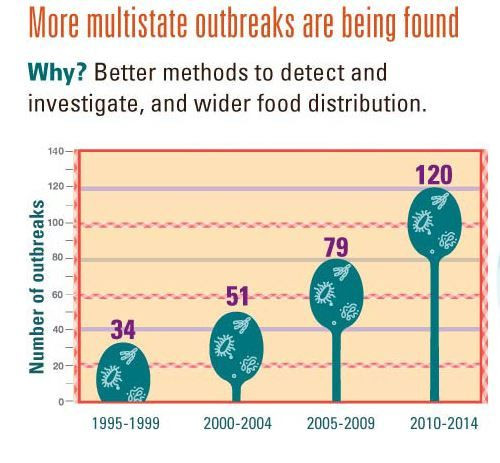Just 3 Germs Cause 91% Of All Multiple State Food Poisoning Outbreaks And Half The Deaths: CDC

Just three germs — Salmonella, E. coli, and Listeria — cause 91 percent of all multiple state food poisoning outbreaks in the United States, according to a new report from the Centers for Disease Control and Prevention (CDC). Importantly, multistate outbreaks account for just 3 percent of all outbreaks, yet they cause more than half the deaths.
The report analyzed data from the CDC’s Foodborne Disease Outbreak Surveillance System for the years 2010 through 2014. The scientists compared the number of illnesses, hospitalizations, and deaths from outbreaks occurring in a single state with outbreaks occurring in two or more states. The team discovered 120 total multistate outbreaks during the five-year period were responsible for 11 percent of all food poisoning illnesses, 34 percent of hospitalizations, and 56 percent of deaths. On average, 24 multiple state outbreaks occurred each year, involving anywhere from two to 37 states.

- Salmonella accounted for the most illnesses and hospitalizations. This germ caused the three largest outbreaks, which were traced to eggs, chicken, and raw ground tuna.
- Listeria caused the most deaths. This was mainly due to a single outbreak in 2011 in which contaminated cantaloupe killed 33 people.
- Imported foods accounted for just 18 of the 120 total reported outbreaks. Mexico imported food was the leading source here, followed by Turkey imported food.
- Overall, Salmonella, E. coli, and Listeria were the most likely contaminants of widely distributed foods, such as vegetables, beef, chicken, and fruits, the CDC explained.
“Americans should not have to worry about getting sick from the food they eat,” Dr. Tom Frieden, director of the CDC, said in a press release.
He added that new gene sequencing tools and advanced epidemiology techniques are used to quickly track down the source of food poisoning outbreaks. By working with national partners, the CDC is helping the food industry to prevent mistakes and accidents from happening in the first place.

Investigations into outbreaks help to reveal the problems that resulted in food becoming contaminated in the first place, while lessons learned help strengthen food safety. New technologies are helping as well.
Over the past six years, for instance, the U.S. Department of Agriculture has taken an increasingly science-based approach to prevent food contamination and illness, making use of more extensive data over the past six years.

Published by Medicaldaily.com



























